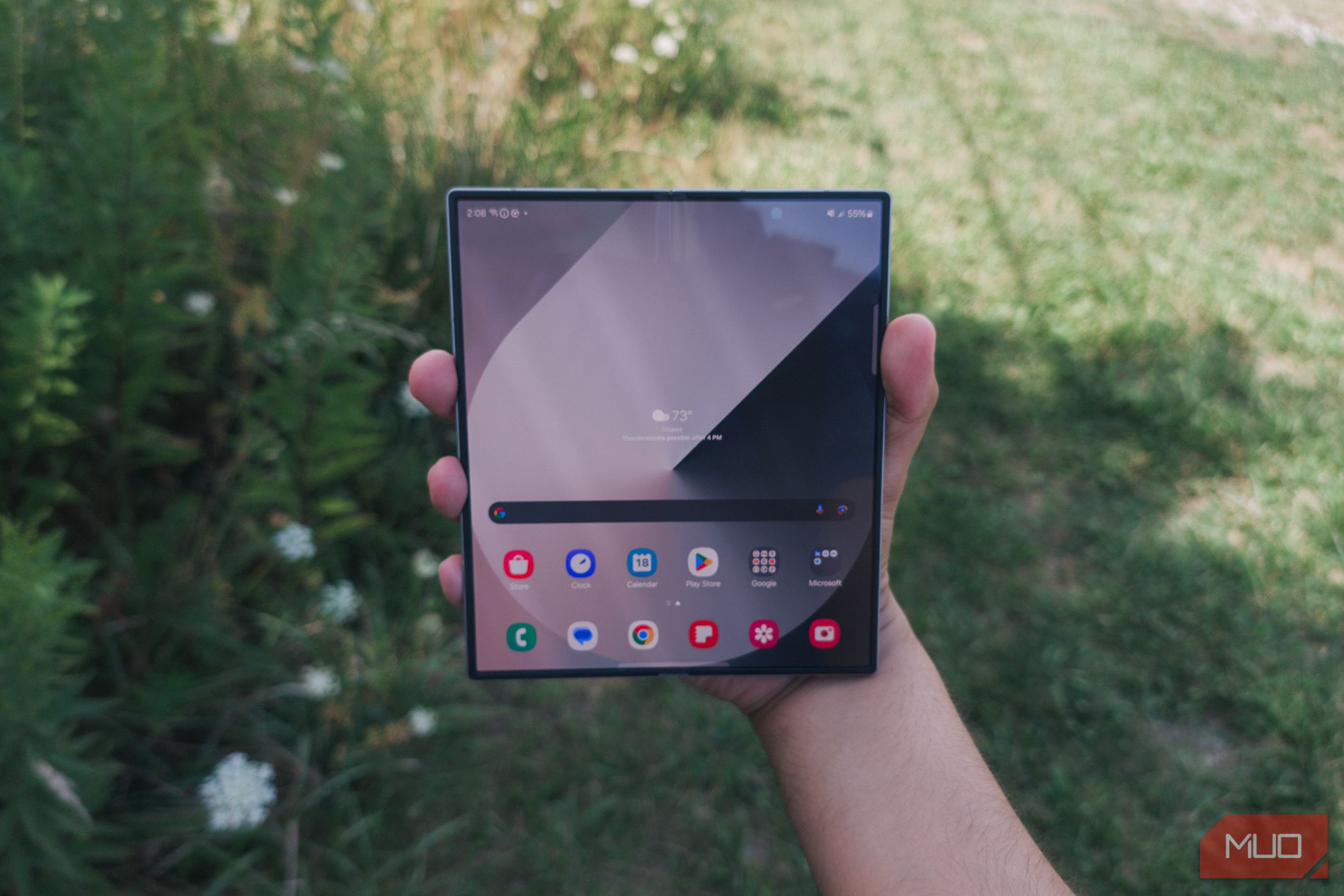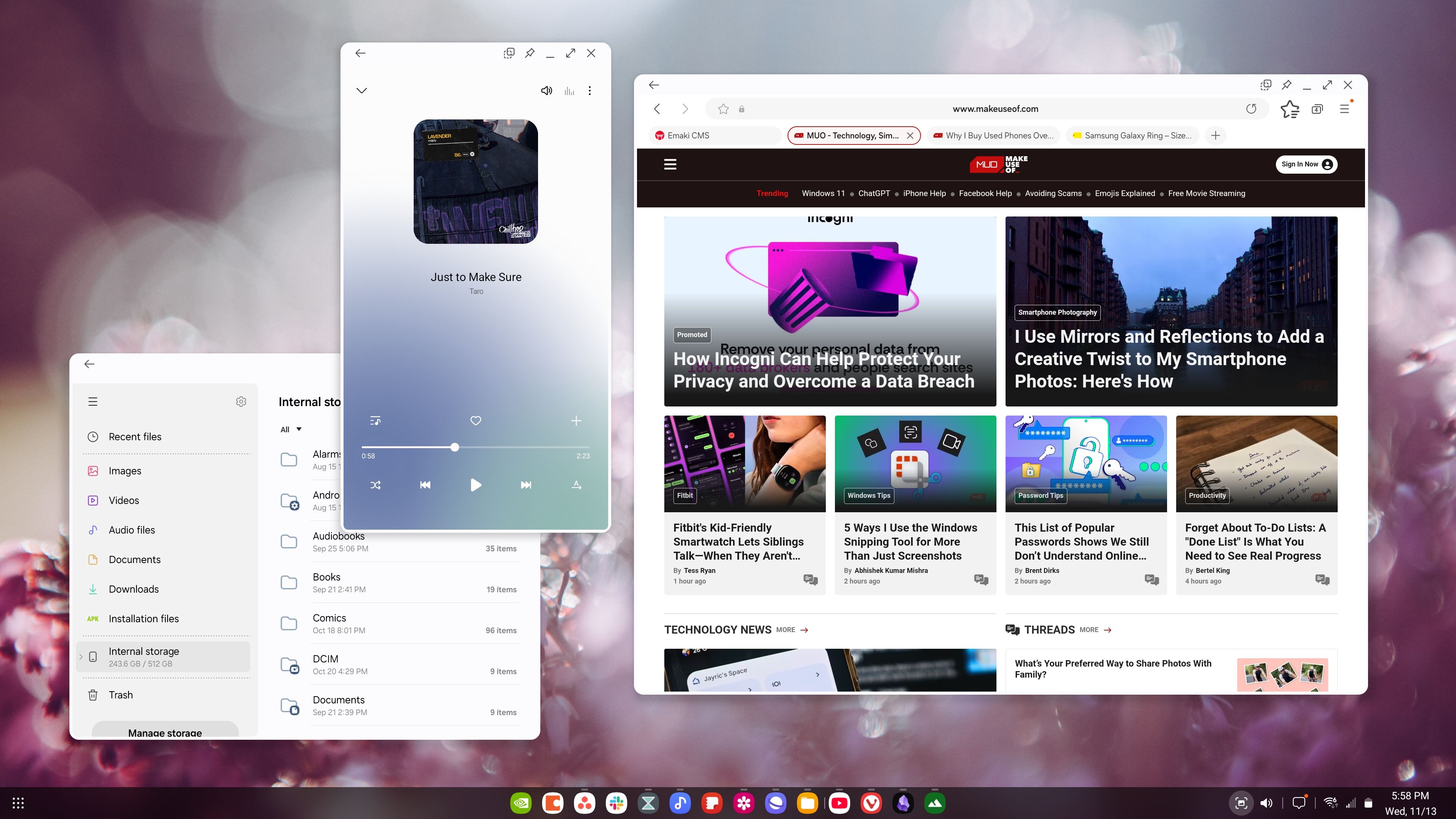Android phones come in many forms, with equally diverse user interfaces. I used to swear by the stock version of Android found on Google’s Pixel phones. However, I now find Samsung’s interface to be the best of them all.
1 One UI’s Distinct Look Still Feels Like Android
Smartphone makers create their own interfaces as part of their effort to differentiate their phones. After all, there’s less reason to be loyal to one brand over another based on phone specs and build quality alone.
Samsung’s older interface, known as TouchWiz, was like a bug repellent to me—I refused to go anywhere near it. That garish look is gone now, replaced with a minimalist interface called One UI that arguably feels more professional and distinguished than Google’s own vision for Android.
On top of that, Samsung’s design no longer clashes with third-party apps. Yes, Samsung’s first-party software has its own look, but you can switch back and forth between other apps without having to adjust your eyes.
2 Samsung’s Attention to Detail and Polish
Some smartphone makers push software interfaces that lack visual consistency and overall polish. For example, consider the Nothing Phone. While you may buy the hardware for its near-iconic look, the software is less visually stunning. The fonts used throughout apps and notification bar are inconsistent. The notification shade has toggles that are weirdly larger than others.
OnePlus’ OxygenOS is serviceable, but the skin strikes me as an awkward blend of Android and iOS. I find the software from both Nothing and OnePlus bland enough to avoid their phones. Why settle for okay when there are better options? Samsung’s OneUI software feels much more fully baked in my opinion.
3 One UI Has a Better Quick Notification Drawer
On a Pixel, the notification drawer doesn’t show all that many toggles. One swipe down just shows me my internet connection, Bluetooth, and two other options. I have to swipe down again to adjust the brightness, and the number of toggles only expands to eight.
By comparison, on my Samsung Galaxy Z Fold 5, I can access six toggles and adjust the brightness, all from the first swipe. The second swipe bumps this number up to 18. Yet even with all these options quickly accessible, the screen still strikes me as clean.
4 Samsung Offers a Powerful Suite of Apps
I used to consider all pre-installed apps from a manufacturer to be bloatware. However, I now find Samsung apps to be some of the best options of their type. As I write this, I’m listening to my local music collection using Samsung Music. Samsung Internet is a stellar web browser that does things Chrome cannot.
Likewise, Samsung Notes is a powerful note-taking app that I use daily, and Samsung Gallery is packed with features that make it far better at managing your local photo library than Google Photos. I have an easier time moving data around with Samsung My Files than I did with the file manager on my old PC!
Sure, most Android devices come with Google’s apps, but they aren’t as appealing to someone like me who isn’t heavily invested in the Google ecosystem. That’s one of the reasons why I won’t switch to a Pixel phone.
5 One UI Scales Well to Larger Screen Sizes
Google developed Android for smartphones, and while tablets are no longer novel, most interfaces still work best on phones.
Samsung has put in the extra work to optimize One UI for larger screens. Built-in features, such as an optional taskbar, help you switch between apps more quickly. You can use two apps at a time in a split-screen view and even pop any app out into a floating window, just like you would on a desktop.
When you want an even more laptop-like experience, you can connect a keyboard and use Samsung DeX on an external display. While Samsung tablets still suffer from having fewer tablet-oriented apps compared to iPads, the company’s interface better adapts to tablets than either OnePlus or Google’s.
6 Native Support for Custom Fonts and Icons
Thanks to the ability to swap out your phone’s Home screen with a third-party launcher, you can radically change the look of any Android phone. These alternative launchers usually allow you to take customization further by grabbing an icon pack.
On a Samsung phone, you don’t need to swap out the default launcher to go all out. You can find icon packs and fonts on the Galaxy Store to change aspects of the interface that most other smartphone makers don’t let you touch. On most phones, changing the icons using a third-party launcher doesn’t impact the icons you see when switching between recent apps. That’s not the case on Samsung devices.
7 Endless Customization and Features for Power Users
The tweaks don’t stop there. Out of the box, I can have an Edge Panel tucked away on the side of my screen that serves as a quick way to launch apps, view notes, check the weather, and much more. I can set all my apps to appear on the Home screen instead of in an app drawer. I can set up modes and routines that tell my phone to do certain things at specific times, in a chosen location, or in response to various variables.
Samsung also provides its own customization tool called Good Lock that lets you configure just about anything you can’t already tweak out of the box. I have my phone set to switch between recent apps when I swipe down from the side of the screen at an angle, saving me from having to reposition my fingers to the bottom of the screen. I removed the blur that appears when managing split-screen apps. I also did away with the gesture navigation bar at the bottom so that my apps fill more of the screen.
Good Lock alone is a good reason for me to stick with Samsung phones. If there’s something visual you wish you could change or a behavior you wish functioned differently, chances are Good Lock will let you tweak it. This is the sort of customization that required us to root our phones or install custom ROMs back in the day.
Many reviewers describe Samsung One UI as doing too much. I don’t see it. The non-techie people I know seem just as able to navigate a Samsung device as a Motorola one. They don’t tend to dive into system settings anyway, so it doesn’t matter all that much that Samsung has packed so many features in there.
For a power user like me, this extra functionality is what enables me to make radical changes to the kind of devices I use. I managed to replace my laptop with a phone, thanks to DeX and Samsung’s extensive multitasking capabilities. I frankly cannot use a Pixel or an iPhone the way I use my Galaxy Z Fold 5, and that’s not because Samsung offers the best hardware; it’s the sheer maturity and capabilities of One UI that draws me to Galaxy phones.



